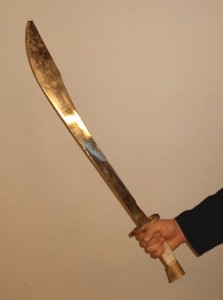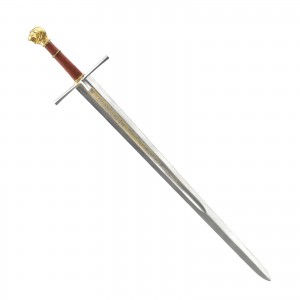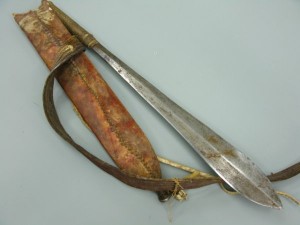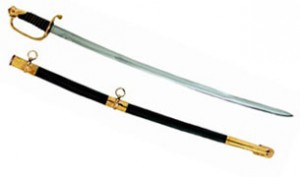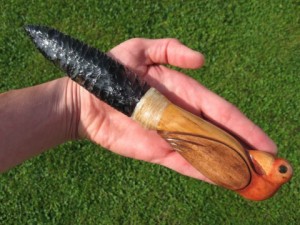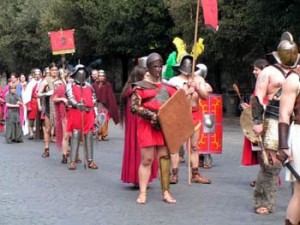This post is the first in a week-long series about swords in conjunction with our first Cutting Edge product give-away. Place a comment responding to this post or any other between today and midnight on Sunday and you’ll be entered to win a 51-inch William Wallace replica sword ($119 value, pictured below).

Picture this: It’s an ordinary Saturday afternoon around your house and your wife is about to leave for bridge club.
“Do you have any plans, honey,” she inquires in a condescending tone, expecting you to have none.
“Actually, I do,” you announce, pulling a 30-inch Katana sword from the sheath affixed to your belt. “I’m going to my sword fighting club.”
All around the world. ordinary dudes like yourself are living exciting lives by participating in sword fighting. Don’t believe me? Here’s a huge list of sword fighting clubs across the U.S.
Not convinced that sword fighting is for you? Here are a few reasons to give it a shot.
Sword Fighting is a Primal Right of Manhood
Have you ever felt like you’ve missed your destiny? Have you ever considered that in a former life you were a swashbuckling pirate or a knight in shining armor who sliced through his foes?
If you have, then you may be completely delusional. However, that doesn’t mean you can’t pick up a sword fighting hobby that’s exciting, healthy and just downright macho.
Sword fighting exhibitions are held every year in locations across the world and you can be a participant. Why sit on the couch twiddling your thumbs when you could be donning armor and fighting it out on the field while living your medieval fantasy
Sword fighting makes you buff
As long as you don’t stabbed through the heart. Have you ever seen a fat Samurai? No, you haven’t, and that’s because there aren’t any.
Sword fighting sheds fat, burns calories and can chisel your body. There are also numerous sword fighting classes available throughout the Hollywood and Manhattan areas, but if by some freakish reason you don’t live in these bastions of new-age exercise, there is no reason to worry. I have a solution for you.
There are books on sword fighting
Seriously. Not only are there books, but there are sword fighting E-books, which means that you can sit in your basement on your laptop and learn to sword fight better then William Wallace.
What could be better than reading an ordinary E-book? How about reading one on sword fighting!
Sword fighting helps you appreciate history
A history book? Yeah, that sounds like a really great way to pass time. But, what if medieval history, had, dare I say, a bit more of an edge to it?
It does. From Lancelot to Miyamoto Musashi, sword fighters have been revered throughout history. Oh, what’s that, you don’t know who Miyamato Musashi is?
He’s an ancient Japanese warrior who won hundreds of duels; In the most infamous, he killed a man with a weapon that he constructed from an oar on the boat-ride over.
Sword fighting is steeped in the tradition and the history of Europe and Asia, which means that in order to fully appreciate it, you’ll want to digest some ancient manuals on the craft. By doing so, you will appear to be much more educated than you are.
Buying a sword is easy
Don’t worry, you don’t need to scour your local sporting goods store for a proper blade. Ninja swords and accessories are available from a number of online retailers and are quite affordable.
Don’t wait any longer. The time has come for you to claim your destiny. Buy a sword (and a sheath) and become the man you’ve always wanted to be.
Want to win a 51-inch William Wallace replica sword ($119 value)? If so, leave a comment below with one reason (no matter how weird) why you’d be proud to own this sword. Everyone who leaves a comment on a Cutting Edge blog post through Sunday will be entered and a winner will be chosen at random.
